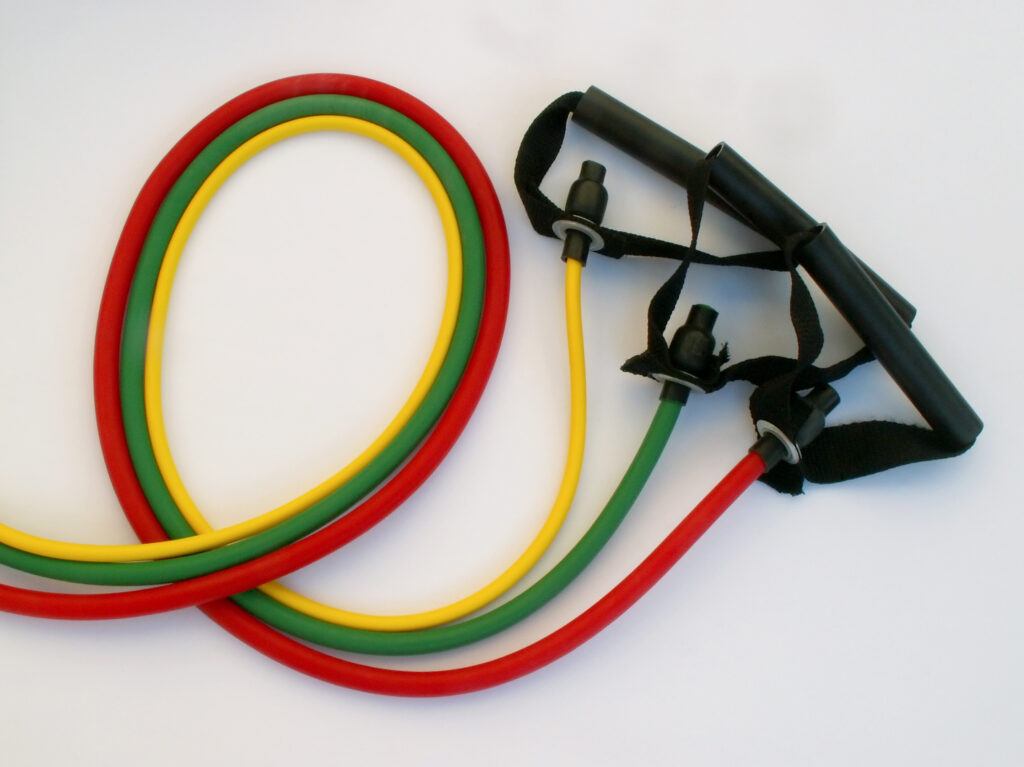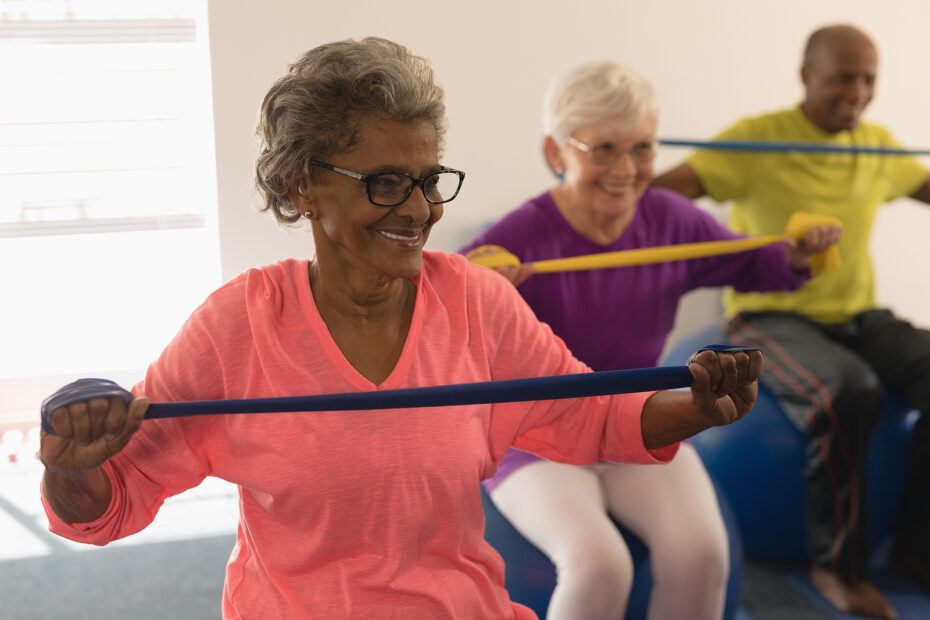Maintaining strength and mobility is important for seniors trying to maintain their independence.
That said, many seniors find traditional exercise routines too strenuous, especially if they deal with joint pain, arthritis, or limited mobility.
That’s where seated resistance band exercises come in.
These exercises provide a gentle (yet effective) way to strengthen muscles from the comfort of a chair.
And resistance bands come with a lot of benefits too – for starters, they’re versatile, lightweight, and easy to use.
They also offer a low-impact workout that can be adjusted to any fitness level, making them perfect for seniors looking to build strength without putting too much strain on their joints.
In this article, we’ll go over some of the best seated resistance band exercises seniors can do, but we’ll also provide some additional tips to help you get the most from your workouts.
After reading, you’ll be ready to make the most from your seated workouts.
Why Use Resistance Bands?
Adding resistance allows you to progress your workouts and make them more challenging, which leads to additional strength gains.
And getting stronger is always a good thing because it makes everyday tasks easier.
When it comes to seated exercises, there are different ways to add resistance, but resistance bands are one of the most popular because they offer so many perks (especially for seniors).
These include:
- Low Impact: Unlike lifting heavy weights, resistance bands provide gentle resistance, which makes them easier on joints and perfect for those with arthritis or other joint issues.
- Versatility: Bands come in different resistance levels, allowing you to start with light tension and gradually increase as your strength improves.
- Improved Mobility and Flexibility: Regular use of resistance bands can help improve range of motion, flexibility, and overall mobility, making everyday tasks easier.
- Convenience: Resistance bands are portable and can be used anywhere—at home, while traveling, or even at the park. They are a convenient way to stay active without the need for heavy equipment.
- Full-Body Workout: With just a resistance band, you can target multiple muscle groups, including your arms, legs, back, and core.

Best Seated Resistance Band Exercises for Seniors
Below are some effective seated resistance band exercises that seniors can incorporate into their daily routine to strengthen muscles, improve flexibility, and enhance mobility.
1. Seated Row
This exercise helps strengthen your upper back, shoulders, and arms, which are essential for maintaining good posture.
- Sit up straight with your feet flat on the floor
- Place the center of the resistance band under your feet and hold the ends of the band in each hand
- Keep your elbows close to your body and pull the band back as if you’re rowing, squeezing your shoulder blades together
- Hold for a few seconds, then slowly release
- Perform 2-3 sets of 10-15 reps
If you have a family member or caregiver, they can also hold the band for you out in front (just make sure you trust them not to let go!).
Check out this YouTube video for a demonstration.
Helpful tip – tie knots in the ends of your resistance band to make them easier to hold while exercising.
2. Seated Leg Press
This exercise strengthens your legs and improves lower body stability, which can help with walking and getting up from chairs.
- Sit in a chair with your feet flat on the floor
- Loop the resistance band around one sole of your feet and hold the ends in your hands
- Extend one leg out in front of you, pressing against the resistance of the band
- Hold for a moment, then slowly return to the starting position
- Perform 10-15 reps and then switch to the other leg
- Perform 2-3 sets of 10-15 reps with each leg
Check out this YouTube video for a demonstration.
3. Seated Chest Press
This exercise targets your chest, shoulders, and arms, helping improve upper body strength and posture.
- Sit tall with your feet flat on the floor
- Place the resistance band behind your back and hold one end in each hand
- Bend your elbows and position your hands at chest level
- Press the band forward, extending your arms straight in front of you
- Hold for a moment and then slowly return to the starting position
- Perform 2-3 sets of 10-15 reps
Try to keep your arms wide throughout the movement and feel free to adjust the height of your shoulders to accommodate any mobility issues.
Check out this YouTube video for a demonstration.
4. Seated Clamshells
This is a great exercise to strengthen the hip abductors, an important muscle group located on the sides of your hips.
These muscles stabilize the pelvis while walking, so keeping them strong can help improve stability on your feet.
- Sit tall with your feet planted on the floor, feet close together
- Wrap your band around the top of your knees and hold in place
- Keeping your feet together, open your knees apart to stretch the band
- Hold for a moment and then slowly return to the starting position
- Repeat for 2-3 sets of 10-15 reps
Check out this YouTube video for a demonstration.
5. Seated Bicep Curl
Strengthening your arms is important for tasks like lifting and carrying objects and this exercise targets the biceps, one of the primary muscles in the arm.
- Sit in a chair with the resistance band placed under your feet
- Hold the ends of the band in each hand, with your palms facing up
- Slowly curl your hands toward your shoulders, keeping your elbows close to your sides
- Hold for a second, then lower your hands back down.
- Perform 2-3 sets of 10-15 reps
FYI, you can easily change this exercise into a hammer curl by turning your hands so that your thumb is pointing up (this variation targets a different arm muscle, the brachialis).
Check out this YouTube video for a demonstration.
6. Shoulder Flexion
This is a great exercise for the shoulders and it can help make things like lifting, reaching, and performing most other daily activities easier.
- Sit tall in your chair with your feet flat on the floor
- Loop the resistance band under both feet, keeping them anchored to the floor
- Grab an end of the band in each hand and start with arms down by your side
- Keeping your elbow straight, lift one hand up in front of you, stopping around shoulder-height
- Slowly return to the starting position
- Perform 10-15 reps on one side and then switch to the other arm
This is a pretty challenging exercise, so you likely won’t need much resistance to get the job done.

7. Band Pull-Aparts
The exercise mentioned above targets the anterior delts, but this exercise targets the often forgotten posterior delts (muscles in the back of your shoulder).
And if you focus on squeezing those shoulder blades together, it also works the important shoulder blade stabilizers, making it a great postural exercise.
- Sit tall in your chair with your feet firmly on the floor
- Grab your band with about a shoulder-width grip out in front of you
- Keeping your elbows straight, squeeze your shoulder blades together as you pull the band apart
- Hold for a second and then slowly return to the starting position
- Repeat for 2-3 sets of 10 reps
This is another exercise where you don’t need much resistance to get the job done. Keep your resistance and light and focus on form.
Check out this YouTube video for a demonstration.
Additional Tips for Using Resistance Bands
Using resistance bands can be a safe and effective way to build strength, but it’s important to use them correctly to avoid injury and maximize the benefits.
Here are some additional tips to help you get the most out of your resistance band workouts:
1. Start Slow and Build Gradually
If you’re new to resistance bands or exercising in general, it’s important to start with a band that offers light resistance.
As you build strength and become more comfortable with the movements, you can gradually move to bands with higher resistance.
Pushing yourself too hard too soon can lead to strain or injury.
You should know that different brands may use different colors to indicate different resistance levels, but man use this scale:
- Yellow – extra light
- Red – light
- Green – medium
- Blue – heavy
- Black – extra heavy
Also, keep in mind that you can increase or decrease your resistance by changing the length of the band as well.
Shortening your grip on the band can increase the intensity, while lengthening can decrease the intensity.
Sometimes you may be able to add/remove resistance without changing bands.
2. Check Your Bands for Wear and Tear
Over time, resistance bands can become worn out, especially if they’re used frequently.
Before each workout, inspect your bands for any signs of damage, such as small tears or thinning material.
Using a damaged band could cause it to snap during exercise, potentially leading to injury. Replace bands that show signs of wear.
3. Secure the Band Properly
To avoid slippage, make sure the band is properly secured under your feet, chair legs, or around your body.
If the band is not positioned correctly, it can slip out of place, reducing the effectiveness of the exercise and increasing the risk of injury.
4. Use Controlled Movements
Always perform exercises with slow, controlled movements.
The key to resistance band exercises is to engage your muscles throughout the entire movement, both when you pull against the band and when you release the tension.
Quick, jerky movements can reduce the effectiveness of the exercise and increase the risk of strain.
5. Breathe Properly
Don’t forget to breathe!
Inhale during the less strenuous part of the movement and exhale when you’re working against the resistance.
Proper breathing helps oxygenate your muscles and can make the exercises feel easier.
6. Maintain Good Posture
When performing seated exercises, always sit tall with your feet flat on the ground and your back straight.
Good posture ensures you’re engaging the right muscles and prevents strain on your lower back and neck.
7. Pair with Other Exercises
Resistance band workouts can be an excellent addition to your regular routine, but consider pairing them with other forms of physical activity like walking, stretching, or other cardio options.
A varied exercise routine can help improve your overall fitness and mobility.
Final Thoughts
Seated resistance band exercises are a stable for most therapy programs because they offer folks a very safe way to build strength.
And with the versatility and ease of use that resistance bands provide, you can target various muscle groups without leaving your chair.
So, whether you’re looking to maintain strength, increase independence, or improve your overall fitness, these exercises can be a valuable addition to your routine.
As always, remember to start slowly, listen to your body, and consult your doctor before beginning any exercises you aren’t sure about.
And remember – pain is not a normal part of exercise!
If any of the above exercises hurt, please adjust or discontinue all together. When in doubt, get a physical therapy consult for professional guidance.
Anyway, I hope you found this article helpful.
If you have any questions or comments, please leave ’em below and I’ll get back to you shortly.



